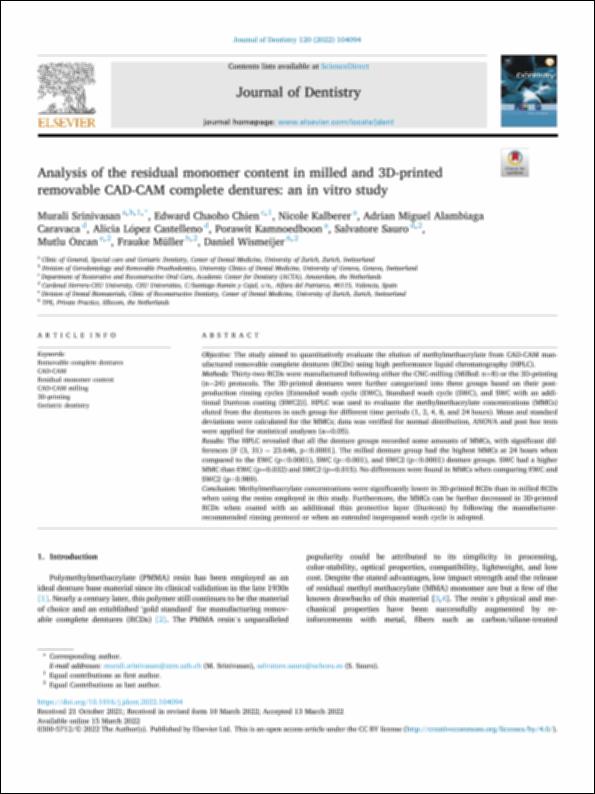Por favor, use este identificador para citar o enlazar este ítem:
http://hdl.handle.net/10637/13948Analysis of the residual monomer content in milled and 3D-printed removable CAD-CAM complete dentures : an in vitro study
| Título : | Analysis of the residual monomer content in milled and 3D-printed removable CAD-CAM complete dentures : an in vitro study |
| Autor : | Srinivasan, Murali Chien, Edward Chaoho Kalberer, Nicole Alambiaga Caravaca, Adrián Miguel López Castellano, Alicia Cristina Kamnoedboon, Porawit Sauro, Salvatore. |
| Materias: | Dentures.; Older people - Dental care.; Odontología geriátrica.; Gomas y resinas sintéticas - Aplicaciones en Odontología.; CAD/CAM systems in dentistry.; Materiales dentales.; Dental materials.; Prótesis dentales.; Sistemas CAD/CAM - Aplicaciones en odontología.; Gums and resins, synthetic in Dentistry. |
| Editorial : | Elsevier |
| Citación : | Srinivasan, M., Chien, E.C., Kalberer, N., Alambiaga Caravaca, A.M., López Castellano, A., Kamnoedboon, P., Sauro, S., Özcan, M., Müller, F. & Wismeijer, D. (2022). Analysis of the residual monomer content in milled and 3D-printed removable CAD-CAM complete dentures: an in vitro study. Journal of Dentistry, vol. 120 (may.), art. 104094. DOI: https://doi.org/10.1016/j.jdent.2022.104094 |
| Resumen : | Objective: The study aimed to quantitatively evaluate the elution of methylmethacrylate from CAD-CAM manufactured removable complete dentures (RCDs) using high performance liquid chromatography (HPLC). Methods: Thirty-two RCDs were manufactured following either the CNC-milling (Milled: n=8) or the 3D-printing (n=24) protocols. The 3D-printed dentures were further categorized into three groups based on their postproduction rinsing cycles [Extended wash cycle (EWC), Standard wash cycle (SWC), and SWC with an additional Dur´econ coating (SWC2)]. HPLC was used to evaluate the methylmethacrylate concentrations (MMCs) eluted from the dentures in each group for different time periods (1, 2, 4, 8, and 24 hours). Mean and standard deviations were calculated for the MMCs; data was verified for normal distribution, ANOVA and post hoc tests were applied for statistical analyses (⍺=0.05). Results: The HPLC revealed that all the denture groups recorded some amounts of MMCs, with significant differences [F (3, 31) = 23.646, p<0.0001]. The milled denture group had the highest MMCs at 24 hours when compared to the EWC (p<0.0001), SWC (p=0.001), and SWC2 (p<0.0001) denture groups. SWC had a higher MMC than EWC (p=0.032) and SWC2 (p=0.015). No differences were found in MMCs when comparing EWC and SWC2 (p=0.989). Conclusion: Methylmethacrylate concentrations were significantly lower in 3D-printed RCDs than in milled RCDs when using the resins employed in this study. Furthermore, the MMCs can be further decreased in 3D-printed RCDs when coated with an additional thin protective layer (Dur´econ) by following the manufacturerrecommended rinsing protocol or when an extended isopropanol wash cycle is adopted. |
| Descripción : | Este artículo se encuentra disponible en la siguiente URL: https://www.sciencedirect.com/science/article/pii/S0300571222001518 En este artículo de investigación también participan: Mutlu Özcan, Frauke Müller y Daniel Wismeijer. |
| URI : | http://hdl.handle.net/10637/13948 |
| Derechos: | http://creativecommons.org/licenses/by/4.0/deed.es |
| ISSN : | 0300-5712 |
| Fecha de publicación : | 8-may-2022 |
| Centro : | Universidad Cardenal Herrera-CEU |
| Aparece en las colecciones: | Dpto. Odontología |
Los ítems de DSpace están protegidos por copyright, con todos los derechos reservados, a menos que se indique lo contrario.


